Sunshine Factory, Co., Ltd. > Applications > Silver-loaded ZrP(Ag ZrP)Silver-loaded ZrP(Ag ZrP)
The structure and antibacterial activity of silver-carried zirconium phosphate Abstract
The structure and antibacterial activity of silver-carried zirconium phosphate (AgZrP) were investigated by X-ray photoelectron spectroscopy(XPS), X-ray diffraction (XRD) and viable cell counting method.
There existed the exchange of sodium ions with silver ions in carrier, and the silver in AgZrP was in ionic state. Moreover, no significant changes in crystal structure of carrier were found by the exchange of silver ions except for its crystal space distance and crystallinity.
The antibacterial tests showed that 100 mg l−1 of AgZrP possessed high antibacterial activity and was capable of killing all the Escherichia coli (E. coli) and more than 99.9% of the Staphylococci aureus (S. aureus) within 8.0 h of contact.
Results and discussion
1. The surface composition and silver valence state of AgZrP
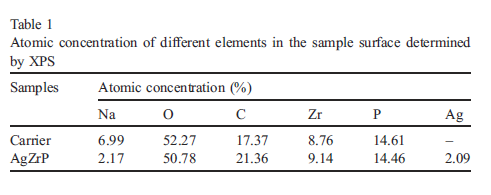
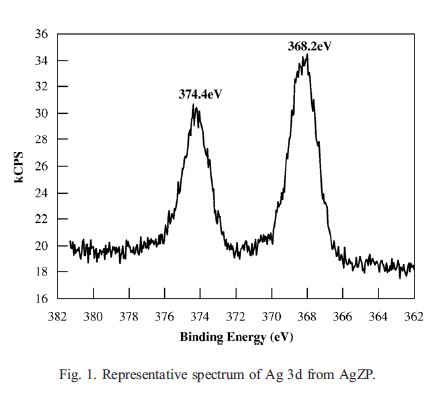
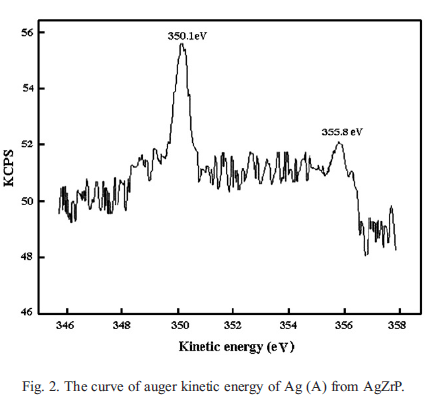 2. The crystal structure of AgZrP
2. The crystal structure of AgZrP
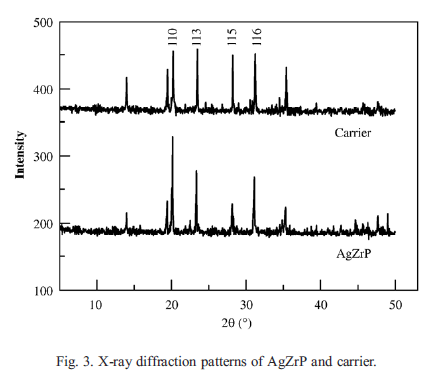
3. The antibacterial activity of AgZrP
The plots of log (viable colonies of bacteria) versus contact time for AgZrP and carrier against E. coli and S. aureus were shown in Fig. 4.
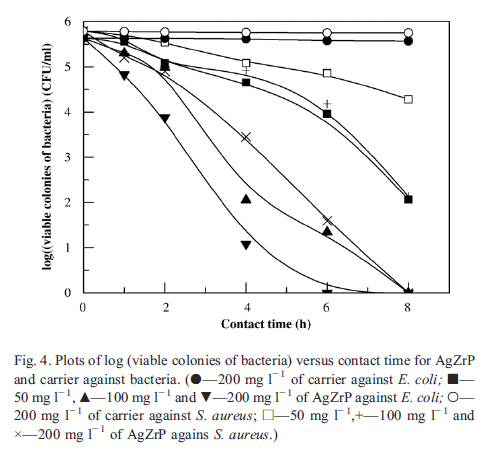 The carrier showed poor antibacterial activity. AgZrP exhibited higher activity against E. coli than against S. aureus under identical test conditions.
The carrier showed poor antibacterial activity. AgZrP exhibited higher activity against E. coli than against S. aureus under identical test conditions.
Keeping the contact time unchanged, the viable colonies of bacteria declined when increased AgZrP concentration.
Increasing AgZrP concentration to 0.1 mg 1−1, all the E. coli and more than 99.9% of the S. aureus were killed within 8.0 h of contact.
These results indicated that AgZrP more than 0.1 mg 1−1 possessed high activity against E. coli and S. aureus.
Conclusion
The structure and antibacterial activity of AgZrP were investigated.
It was found that the exchange of sodium ions with silver ions in carrier was confirmed, and the silver in AgZrP was in ionic state.
The crystal structure of carrier was not obviously affected by the exchange of silver ions except for its crystal space distance and crystallinity. The antibacterial tests showed that 100 mg 1−1 of AgZrP possessed high antibacterial activity and was capable of killing all the bacteria of E. coli and more
than 99.9% of the S. aureus within 8.0 h of contact.
There existed the exchange of sodium ions with silver ions in carrier, and the silver in AgZrP was in ionic state. Moreover, no significant changes in crystal structure of carrier were found by the exchange of silver ions except for its crystal space distance and crystallinity.
The antibacterial tests showed that 100 mg l−1 of AgZrP possessed high antibacterial activity and was capable of killing all the Escherichia coli (E. coli) and more than 99.9% of the Staphylococci aureus (S. aureus) within 8.0 h of contact.
Results and discussion
1. The surface composition and silver valence state of AgZrP




3. The antibacterial activity of AgZrP
The plots of log (viable colonies of bacteria) versus contact time for AgZrP and carrier against E. coli and S. aureus were shown in Fig. 4.

Keeping the contact time unchanged, the viable colonies of bacteria declined when increased AgZrP concentration.
Increasing AgZrP concentration to 0.1 mg 1−1, all the E. coli and more than 99.9% of the S. aureus were killed within 8.0 h of contact.
These results indicated that AgZrP more than 0.1 mg 1−1 possessed high activity against E. coli and S. aureus.
Conclusion
The structure and antibacterial activity of AgZrP were investigated.
It was found that the exchange of sodium ions with silver ions in carrier was confirmed, and the silver in AgZrP was in ionic state.
The crystal structure of carrier was not obviously affected by the exchange of silver ions except for its crystal space distance and crystallinity. The antibacterial tests showed that 100 mg 1−1 of AgZrP possessed high antibacterial activity and was capable of killing all the bacteria of E. coli and more
than 99.9% of the S. aureus within 8.0 h of contact.

Follow WeChat


